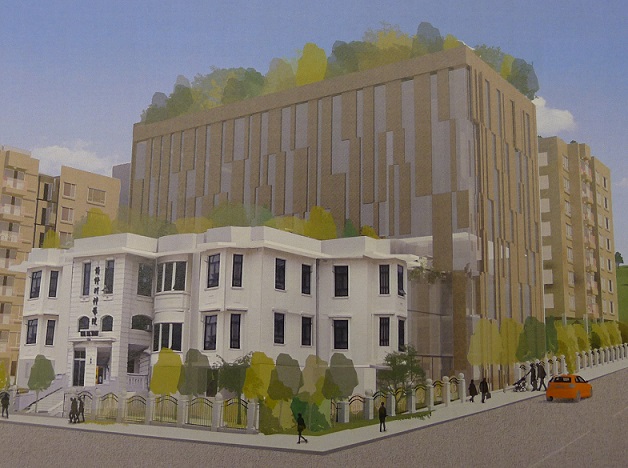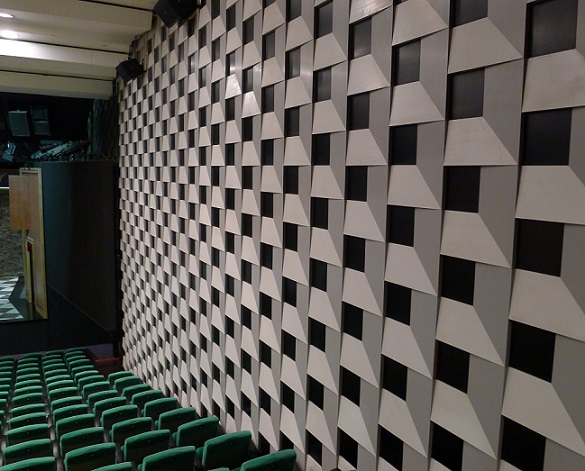Reviews & Articles
優秀的城市都是觸覺敏銳的城市 ∣ Great Cities are Sensitive Cities
John BATTEN
at 11:07am on 16th November 2016


圖片說明 Captions:
1. 建築師對九龍城伯特利神學院的構思圖 Architect’s rendition of Bethel Bible Seminary extension in Kowloon City - showing architect's design behind the heritage Sun Hok building
2. 中環大會堂內部 Interior of City Hall Theatre, Central
(Please scroll down for English version)
《怎樣的城市才是「優秀的城市」?》,這大概會是香港各大國際商會聯同訪港商人主辦活動的主題,旨在推廣「趣味、活力和創意」。這也可以是香港的大學 、政府部門、非政府機或業界組織舉辦座談會時選用的題目,由一組訪問學人給予智者的意見。然而,在這種清談場合,好意念往往在說出口的一刻後便告消失。
珍.雅各(Jane Jacob)影響深遠的著作《偉大城市的誕生與衰亡:美國都市街道生活的啟發》(The Death and Life of Great American Cities,1961年出版)最能解釋一個優秀的城市應具備哪些城市規劃特質。雅各的其中一項觀察到了今天仍然未變,就是安全的街道,就是那些人類活動頻繁的地方。良好的人類活動正正與觸覺敏銳的城市規劃息息相關,能讓人們善用街上的空間。雅各的概念簡單而合理,當時不少學者最初都看不起她的想法。例如在上世紀五、六十年代,美國人對汽車著迷,這個情況在現今香港仍然發生,六線行車的天橋會切過早已建成的市區範圍,活活地扼殺了有機形成、朝氣勃勃的社區,天橋底下的新建成空間亦變成「死位」。由於沒有街道活動,這些空間事實上也相當危險。建築本身無可避免地帶來了公眾不希望看見的活動。
可以理解,香港的城市規劃運動活躍份子會集中在這類問題上:香港的城市規劃欠佳,街道環境並不友善。我們很幸運,優美的維多利亞港和圍繞著它的山巒疊嶂,加上兩岸高低有致的建築物,讓我們擁有壯闊的風景,那種熟悉感溫暖而伸手可及。在旺角等人聲鼎沸、百業興盛的地區支持下,香港的氣氛得到進一步提升。優秀的城市需要一種特別而有機,而不是刻意製造出來的氛圍。維港與旺角的熙來攘往,為香港即時注入了那種獨特氣氛。
顯然地,這一切都值得我們保護!保護行動可以由你身邊的角落展開,由個別建築物、美麗的室內和室外空間、城市舊區和郊野開始。我們對香港的愛,正是由這些地方裡的每一個人累積而來。這些地方中,有些可能未被我們認識、印象模糊,例如你可能從未步進香港大學附近的聖安多尼堂。路過時不妨進去看看,教堂的室內設計是簡約現代主義的典範。來到中環大會堂時,試試拾級而上,走進劇院看看它以幾何圖案拼成的牆壁:香港藝術家何倩彤便把它比喻為「梯形的宇宙」––確實如此!寧靜的空間瀰漫著幾乎叫人景仰的氣氛,最能打動參觀者的美學神經。
同樣地,在馬克.羅斯科(Mark Rothko)的新傳記中,他的兒子基斯杜化這樣解釋父親抽象畫作很多時候都被觀眾感受:
「事實上,我最常在喜歡羅斯科作品觀眾口中聽到的形容詞,是『動人』。這是一個很重要的詞語,因為它帶出了作品與我們身體上的情感回應。我們欣賞畫作後來到這樣基本的層面,對作品有身體機能的反應。我們到達了一個關鍵位置,我們神經系統中的物理、化學和思想驅動元素互相產生作用,一同創造出一種情感反應……當觀眾與畫作之間真正產生互動時,可以觸動人的心弦,而那個反應,正是基本、身體和非自願的,最少有部份如是。」
「非自願」的說法可說最準確不過。不管是氣氛剛好的地方,還是在美學上吸引眼球的畫作,你所看所感的即時反應都是非自願的。英語中「相信直覺」會以「go with your gut feeling」(直譯正是隨著腸子裡的感覺行動)來形用,這裡便十分適用:你所感受到的美好應該會是美好的;你覺得不對勁的往往也是不對勁的。
香港不但沒有良好的城市規劃,還欠缺對保護空間應有氣氛和優美環境的觸覺。最近期的例子,要數可能被清拆的北角皇都戲院。對於這座地標建築物,任何不原座保留的行為都是愚不可及的。政府,是時候行動了,快從我們的財政儲備拿點出來回購皇都戲院,把它重新建造成劇院:市民都會樂於光顧,更重要的,是我們都會再次愛上它!
另一個例子在九龍城。伯特利神學院多年前與政府達成協議,同意原址保留神學樓。現在,他們想在歷史建築神學樓後面興建一座大型新翼。新翼的設計難以置致信地欠缺觸覺,與神學樓本身的歷史和對面民生書院的低樓歷史格格不入。這種醜陋的設計是不能接受的。古物 諮詢委員會和古物古蹟辦事處,是時候行動了:快拒絕這項申請!
參考資料:www.info.gov.hk/tpb/tc/plan_application/A_K18_322.html
原文刊於《明報周刊》,2016年10月29日。
Great Cities are Sensitive Cities
John Batten
What makes a “great city”? It’s the sort of a topic one of Hong Kong’s international chambers of commerce might organise with a visiting businessman promoting “fun, vibrancy and innovation.” Or, it could be a seminar title that a Hong Kong university, government department, NGO or industry organisation builds around a group of visiting academics giving sage advice. In such talk-shops, any good ideas often disappear as quickly as they are uttered.
Jane Jacob’s seminal book The Death and Life of Great American Cities (1961) best explains the urban planning attributes of good cities. One of her observations, which holds true today, is that safe streets are streets that are vibrant with human activity, and good human activity is related to sensitive urban planning allowing people to use the streets. Jacob’s concepts were so plainly sensible that academics were initially dismissive of her ideas. For example, in car-obsessed 1950s and 60s USA, and still happening today in Hong Kong, the construction of a six-lane road overpass through an established urban area kills an organic, vibrant community and creates ‘dead’ newly built areas, the space below an overpass, that is actually dangerous because there is no street activity. The architecture itself inevitably attracts undesirable activities.
Urban planning activists in Hong Kong understandably concentrate on such issues: the city’s poor urban planning and unfriendly street environment. We are lucky that the magnificent Victoria Harbour and its surrounding steeped hills with layers of different building heights give an instant panorama-landscape ambience and a warm, palpable familiarity. Hong Kong’s ambience is further reinforced by such places as Mong Kok with its exciting waves of human and commercial activity. Great cities need a special organic, not contrived, ambience. Victoria Harbour and Mong Kok’s buzz give Hong Kong that special instant ambience.
It is all so obviously worth protecting! Protection starts around the corner from you – it starts with individual buildings, beautiful indoor and outdoor spaces, older urban neighbourhoods and our countryside. Our love for our city is an accumulation of every one of these places. Some maybe unknown or obscure, you have probably never entered St Anthony’s Church, near the University of Hong Kong: do pop in, its interior is minimal modernism at its best. Or, walk upstairs anytime and look inside the City Hall Theatre in Central: Hong Kong artist Ho Sin Tung described the theatre’s geometric wall decoration as “the trapezoid universe” – and it is! Spaces that have a quiet, almost reverent-like atmosphere hit a viewer’s aesthetic nerve.
Similarly, in a new biography of Mark Rothko, his son Christopher Rothko explains how his father’s abstract paintings were often felt:
“The word I most frequently hear from viewers who love Rothko’s work is, in fact, moving. The word is significant because it speaks to the physicality of our emotional response. We are on such an elemental level that we are having a bodily reaction to the work. We are at the critical place where the physical, the chemical, and the thought-driven elements of our nervous system come together to produce an emotional reaction…when the interaction between viewer and painting really occurs, a chord is struck and the reaction is, at least in part, basic, physical, and involuntary.”
‘Involuntary’ is most accurate. Whether it is a place with the right ambience, or art that is aesthetically engaging for the viewer, the immediate reaction to what you are seeing and feeling will be involuntary. That old phrase, “go with your gut feeling” is applicable here – what you experience that is good is probably good, and that which is bad is probably bad.
Alongside good urban planning outcomes, Hong Kong also lacks much sensitivity to the protection of a place’s ambience and aesthetic excellence. The latest examples include the possible demolition of the old State Theatre in North Point. This is such a landmark building, anything less than its intact preservation would be stupid. Go on government, spend some of our fiscal reserves and buy it and turn it back into a theatre – it will be well patronized and, importantly, loved!
And then in Kowloon City, the Bethel Bible Seminary made a deal with government years ago and agreed to the preservation of its headquarters. Now they want to build a large extension behind the Sun Hok heritage building. The design is incredibly insensitive to its own heritage and the low-rise history of Mansung College across the road. Such an ugly design is unacceptable. Go on Antiquities Advisory Board and Antiquities & Monuments Office: reject this design!
See: http://www.info.gov.hk/tpb/en/plan_application/A_K18_322.html
This essay was originally published in Ming Pao Weekly, 29 October 2016
|
|
|
|
|
|
